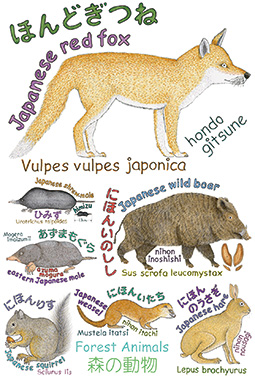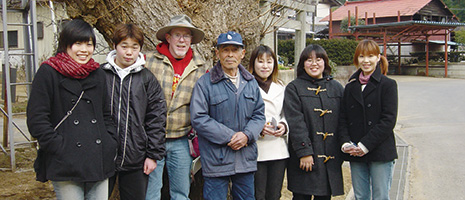

Information cards illustrated by Short for use in nature observation sessions
February 2021
Satoyama—Where People and Nature Meet

American anthropologist and naturalist Kevin Short has spent much of his life in Japan sharing his fascination with satoyama through his writings, lectures and other activities.

There are many areas of Japan where the traditional countryside landscape, known as “satoyama,” or “satochi,” can still be found. According to the Ministry of the Environment, Japan, satoyama is “an area consisting of farmlands, irrigation ponds, secondary forest, plantation forest, and grasslands around human settlements.” It is often located between mountainous areas and urban areas, and the environment and landscape are maintained through human interventions.
US native Kevin Short writes, lectures and conducts research on satoyama. Short first came to Japan in 1972. Back then, he was responsible for maintaining telecommunication systems at the US military base in Zama City, Kanagawa Prefecture. On his days off, he would travel within Japan, which led to an interest in the country’s nature, culture and history. Short took evening classes in Japanese at Sophia University, graduating in 1975. He went on to major in cultural anthropology at Stanford University, receiving his PhD in 1991. Until March 2020, he was a professor at Tokyo University of Information Sciences in Chiba City, Chiba Prefecture, where he was engaged in research and teaching. Short is now retired and devotes himself to researching satoyama and other aspects of the relationships among people and the natural world in Japan. He is especially interested in the spiritual components of these relationships.
Short married and started a family in 1980. Since 1987 he has been living in Chiba New Town, a large residential area in northwest Chiba Prefecture between central Tokyo and Narita Airport. Prior to the development of land for housing, the area was entirely rural, and the satoyama landscape of rice paddies, irrigation ponds and thickly wooded areas still remains today. It is the perfect environment for his research activities, and Short continues to conduct fieldwork here on the origins and present state of satoyama.
“The spiritual culture of the Japanese people has taken root in satoyama over a long period of time,” says Short. The Japanese folk spirituality is based on a strong belief that humans rely heavily on the gifts of nature. People have not taken these gifts for granted, always expressing their appreciation in prayers, ceremonies and festivals. For example, hunters used to chant messages of gratitude to the mountain deities whenever they were blessed with a deer, boar or bear. People everywhere in Japan have erected chinjusha shrines dedicated to the tutelary deity of their village or neighborhood. These shrines are often surrounded by a dense grove of native trees known as a chinju no mori (sacred shrine forest). These forests offer habitat to various wildflowers and birds such as owls and woodpeckers. Today, these beautiful, lush forests with their abundance of towering evergreen broadleaved trees, bearing a close resemblance to the natural environment of the past, can still be found all over the country.
“Satoyama is a landscape created from the interaction among the original natural environment, people’s daily livelihood activities, and local ideas and values concerning humans’ role in the natural world,” says Short.


Over more than three decades, Short has been sharing his thoughts and observations about satoyama in a series of newspaper columns as well as in books such as Kebin no satoyama shizen kansatsuki (A Naturalist in the Japanese Countryside) and Nature in Tokyo, an English-language guide to plants and animals in and around Tokyo. Short’s stories and books are accompanied by many of the author’s own photographs and drawings depicting all aspects of the satoyama countryside landscape, including not only flora and fauna, but folk beliefs as well. The soft and warm touch of Short’s illustrations shows his deep appreciation of Japanese nature and culture.
Short also guides nature hikes and observation classes at various satoyama spots in Chiba Prefecture. For example, one non-profit organization that sponsors these activities is Y. Y. NOWSON, set up in 2014 by groups researching local natural farming methods and locally produced food. This group works closely with the Tokyo University of Information Sciences to provide opportunities for learning about satoyama conservation and rural communities through hands-on experience. As well as continuing to write, lecture and run hands-on nature programs, Short hopes to start using social networking sites and other digital channels to disseminate his information more efficiently.
“I believe that the traditional Japanese satoyama, where people create a sustainable lifestyle by co-existing with nature, has significance and value on a global scale now that the world is facing serious environmental problems.” Says Short, “In the near future I also want to explore the roots of satoyama by delving into old Japanese myths and folk beliefs, and wander around the places where those stories are handed down.”
Kevin Short has devoted his life to understanding the unique relationships that the Japanese people have developed with their island world. He is passionate about cultural landscapes like the satoyama, and believes that people both in Japan and around the world have much to learn from this.

